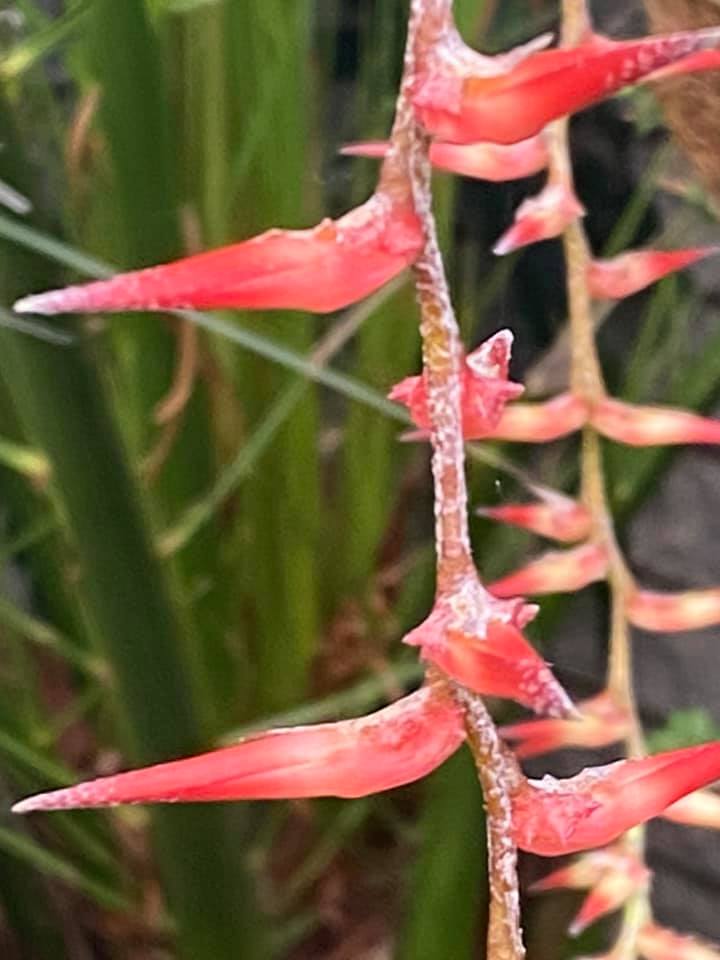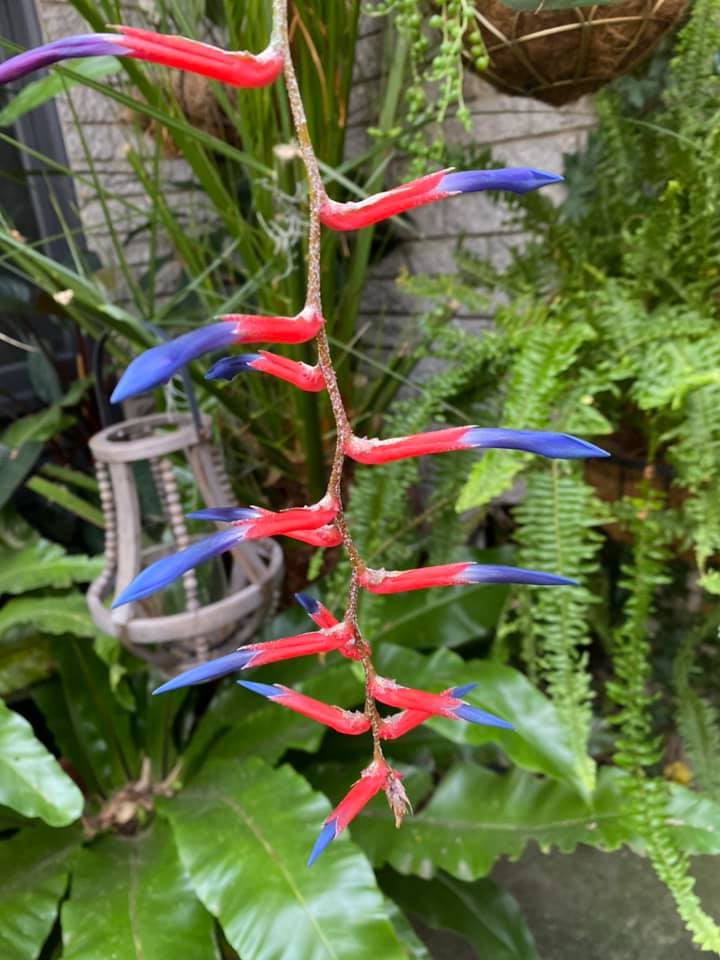






PLANT flowering 0.9-1.3 m high, spreading by short basal sprouts.
LEAVES 8-11, 54-140 cm long, the external ones reduced, suberect, sometimes arched towards the apex, subcoriaceous, forming a narrow-infundibuliform rosette;
LEAF SHEATHS oblong, 11-30 cm long and 4-10.5 cm wide, slightly wine coloured on in the adaxial face, dense-scaled on both faces;
LEAF BLADES ligulaye, 40-117 cm long and 2.7-9 cm wide, margins spinulose, spines 1 mm long, apex wide to narrow-acute, rarely rounded-cuspidate, ending in a rigid spine 3-7 mm long, green, grey scaled mainly on theabazial face.
SCAPE sub-pendulous or pendulous, central, (37)50-110 cm long. and 2-4 mm diam., green, scattered indument, cobwebby;
SCAPE BRACTS erect, narrow-lanceolate, margins entire or rarely small and iregularly serrulate, narrow-acute apex, 6-18 cm long and 1.1-1.5 cm wide, green or rosy, papyraceous, scattered indument, cobwebby, or glabrescent.
INFLORESCENCE simple, lax to sublax, long cylindrical, with 26-70 flowers, (7)10-61 cm long, green rachis;
FLORAL BRACTS sub-spreading, with a wide base, sub-auricular, conspicuously wavy, and narrow-acute apex, margins entire to serrulate, the lower ones equalling or exceeding the sepals, the upper ones exceeded by the sepals, ecarinate, 1.5-6 cm long and 0.8-1.5 cm wide, greenish yellow, papyraceous, indument scattered cobwebby, or glabrescent.
FLOWERS polystichous, sessile, 3.5-5.3 cm long;
SEPALS free, oblong, strongly asymmetrical, apex acuminate-mucronulate, sometimes recurved in a short hook, ecarinate, 2-3 cm long and 0.7-0.8 cm wide, red or green-red, glabrous;
PETALS free, spatulate, acute apex, sub recurved or rarely strongly retroflexed at anthesis, 3.8-4.3 cm long and 0.6-0.8 cm wide, violet becoming white towards the base, glabrous;
PETAL APPENDAGES two per petal, basal, fimbriate at the apex, ca. 2 mm long and 11 mm wide, adnate to the petal 0.5-1.0 mm from the base; two longitudinal callosities per petal, parallel and flanking the staminal filaments, 2.4-3.0 cm long and 1.5 mm wide;
STAMENS shorter than the petals;
FILAMENTS filiform, 3.0-3.5 cm long and 1.0 mm wide, the antipetalous ones adnate to the petals ca. 1.5 cm;
ANTHERS subexserted to exserted, dorsifixed near the middle, oblong-lineal, ca. 6 mm long and 1 wide, obtuse base, apex acuminate, whitish;
POLLEN biporate, oblate, reticulate;
STYLE 3.6-3.9 cm long, violet;
STIGMA conduplicate-spiral, stigma lobes frequently lax during anthesis, ca. 4 mm long, exceeding the anthers by ca. of 3-4 mm, violet, lobes with margins minutely papillose;
OVARY subtrigonous, ca. 0.6 cm long and 0.6 cm diam., red or yellowish, placenta joined to the middle of the ovary; ovules numerous per locule, anatropous, obtuse;
EPIGYNOUS TUBE ca. 2.0 mm long and 3.0 mm diam.
FRUITS subtrigonous, ca. 2.6 cm long and 1.0 cm diam., when ripe red or yellowish, pulp hyaline, sweet; seeds claviform ca. 1.5 mm long.
Material examined: RIO DE JANEIRO: Itatiaia - Serra de Jose Vaz, 26.VII.1874, fl., Glaziou 7500 (C, photo F,K,S); Parque Nacional de Itatiaia, Maromba, 18.VI.1930, fl., Brade 10079 (R); idem, 19.VII.1935, fl., Brade 14954 (RIB); idem, 30.VI 1939, fl., M.B.Foster 120 (R); idem, picada Barbosa Rodrigues, 13.VI 1942, fl., W.D.Barros 960 (ITA); idem, fazenda da Serra, VII 1959, fl., H.E.Strang 108 (R); idem, 31.VII.1965, fl., A.Castellanos s/n. (GUA); idem, 25.VI 1970, fl., S.V.de Andrade s/n. (ITA); idem, abrigo IV, 22.VI 1995, bt., J.M.Braga 2492 (RB); idem, cultivada por C.M.Vieira, 2.VII.1997, fl., C.M.Vieira 985 (RB); Petropolis - Rocinha, Pedro do Rio, 15.V.1968, fl., D.Sucre 3084 et al.(RB); base da Pedra Maria Comprida, 28.VII.1968, fl., D.Sucre 3337 et al.(RB); Araras, 20.X.1974, fr., G.Martinelli 517 (RB); idem, 16.VII.1976, fr., G.Martinelli 1026 (RB); travessia Araras-Secretario, proximidades da Pedra Roxa, 1.XII.1997, fr., C.M.Vieira 1145 et al. (R); idem, cultivada por L.C.Gurken, 26.VII.1998, fl., C.M.Vieira 1228 et al. (R). Sumidouro - Sao Caetano, proximidades do morro Duas Irmas, 15.VII.1997, fl., C.M.Vieira 974 et al (RB); idem, cultivada por C.M.Vieira, 16.VI 1998, fl., C.M.Vieira 1232 (R).
Additional Material: s/loc., cultivada no Jardim Botanico da Universidade de Vigosa, 29.VI.1979, fl., W N.Vidal 483 et al. (HB). MINAS GERAIS: Teixeira Soares, VIII.1908, fr., A.J.Sampaio 813 (R)
Ecological data: Plants rupicolous or epiphytic, endemic to the southeast portion of the Atlantic Pluvial Forest. It occurs on the hillsides of the serras do Mar and the Mantiqueira, at altitudes from 400 to 1200 m/s.m.
It was recorded in flower in the months of May to July, fruits being observed in July to December. Martinelli (1994) verified for this species the occurrence of fruits in March.
Geographical distribution: Minas Gerais and Rio de Janeiro (Fig. 14).
Comments: Wawra (1880) described Q. augusto-coburgii based on specimens collected during his second expedition to Brazil. Three years later, Wawra (1883) published a work in the which supplied descriptions and prints of the species collected in this trip. In spite of the loss of the type material of Q. augusto-coburgii deposited in the Herbarium Museum of Natural History in Vienna (W), the print of this species supplied by Wawra (1883) constitutes a good representation of the taxon, for this to be designated hereafter as a neotype in case the absence of isotypes of this material is confirmed.
When placing this species in the genus Quesnelia, Wawra (1880) seemingly took into account the presence of filaments opposite the petals adnate to the petals and of ovules not caudate. Baker (1889), although commenting that this species did not agree well with the genus Quesnelia or with any other genus then known, opted to maintain unaffected the placement by Wawra (1880).
Mez(1896), when transferring this species to the subgenus Wawraea, treated this species next to Q. indecora Mez, Q. blanda (now Q. strobilispica) and Q. lateralis. Later, Smith & Downs (1979) transferred Q. augusto-coburgii to the subgenus Billbergiopsis.
Quesnelia augusto-coburgii is easily identified from the original description and illustrations, being, in general, well defined in relation to other known taxa. It was treated by Smith & Downs (1979) next to Q. indecora Mez, an endemic species in the states of Minas Gerais and Espírito Santo, and stands out from Q. augusto-coburgii by having smaller inflorescences (to 5.0 cm long), flowers more densely arranged and sepals with smaller dimensions (to 1.9 cm long).
With restricted and fragmented distribution, it shows the importance of the occurrence of Q. augusto-coburgii in conservation areas, amongst which stands out the Parque Nacional de Itatiaia. In spite of occurring in highland habitat included in the Environmental Protection Area of Petropolis, the local survival of this species is not guaranteed in view of the periodic fires and to growing civilisation pressure in the area.
Desc from S&D.
Quesnelia augusto-coburgii Wawra, Osterr. Bot. Zeitschr. 30: 150. 1880.
Plant propagating by erect basal slips and by stout rhizomes, flowering 1-1.3 m high with the inflorescence extended.
Leaves few in a cylindric rosette, the outer much reduced and pale, the inner to over 1 m long;
sheaths scarcely wider than the blades, very indistinct, green, covered with pale appressed scales on both sides;
blades ligulate, broadly acute with a dark brown spinose apex, laxly serrate with spines to 1 mm long, densely pale-lepidote beneath, soon glabrous above.
Scape decurved, slender, soon glabrous;
scape-bracts erect, clasping, exceeding the internodes, narrowly lanceolate, acute, membranaceous, greenish or rose, sparsely pale-lepidote.
Inflorescence simple, pendulous, elongate, lax.
Floral bracts spreading with the flowers, subreniform with a narrowly triangular apex, coarsely serrate, about equaling the sepals, submembranaceous, pale brown or yellow-green, sparsely pale-lepidote, soon glabrous;
flowers sessile.
Sepals free, asymmetric, subelliptic, abruptly acuminate, 22-27 mm long, membranaceous, red, glabrous;
petals to 43 mm long, dark blue, recurved at anthesis and exposing the anthers, bearing 2 fimbriate scales;
stamens much shorter than the petals;
pollen ellipsoid, biporate;
ovary ellipsoid, triangulate with dorsal angle alate, glabrous, epigynous tube large; placentae subapical.
Type. Wawra II-185 (holotype, W, lost), Juiz da Fora, Minas Gerais, Brazil, or typified by the original description and the illustrations in Wawra, It. Sax.-Cob. 453, p1s. 28, 35B. 1883.
Distribution. Epiphytic, to 1000 m alt, Minas Gerais and Rio de Janeiro, Brazil.
BRAZIL. Saint-Hilaire .s n (P). Minas Gerais: Juiz da Fora, Wawra l1-196 (! Mez). Rio de Janeiro: Rezende, 26 Sep 1874, Glaziou 7500 (P, photo GH); Itatiaia, 30 Jun 1939, Foster 120 (GH, US).